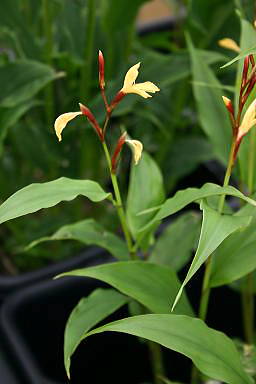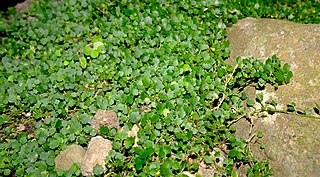
Asteraceae is a large family of flowering plants that consists of over 32,000 known species in over 1,900 genera within the order Asterales. The number of species in Asteraceae is rivaled only by the Orchidaceae, and which is the larger family is unclear as the quantity of extant species in each family is unknown. The Asteraceae were first described in the year 1740 and given the original name Compositae. The family is commonly known as the aster, daisy, composite, or sunflower family.

The stamen is a part consisting of the male reproductive organs of a flower. Collectively, the stamens form the androecium.

The family Campanulaceae, of the order Asterales, contains nearly 2400 species in 84 genera of herbaceous plants, shrubs, and rarely small trees, often with milky sap. Among them are several familiar garden plants belonging to the genera Campanula (bellflower), Lobelia, and Platycodon (balloonflower). Campanula rapunculus and Codonopsis lanceolata are eaten as vegetables. Lobelia inflata, L. siphilitica and L. tupa and others have been used as medicinal plants. Campanula rapunculoides may be a troublesome weed, particularly in gardens, while Legousia spp. may occur in arable fields.

Hemiandra is a genus of nine species of flowering plants of the family Lamiaceae and is endemic to Western Australia. Plants in the genus Hemiandra are shrubs with sessile leaves arranged in opposite pairs, petals with five lobes arranged in two "lips" and the fruit a capsule usually containing four nuts.

Calyceraceae is a plant family in the order Asterales. The natural distribution of the about sixty species belonging to this family is restricted to the southern half of South America. The species of the family resemble both the family Asteraceae and the Dipsacaceae.

Lobelia siphilitica, the great blue lobelia, great lobelia, or blue cardinal flower, is a plant species within the family Campanulaceae. It is an herbaceous perennial dicot native to eastern and central Canada and United States. There are two recognized varieties of Lobelia siphilitica, var. siphilitica and var. ludoviciana. Blooming from August to October, it is short-lived, lasting only for a few years.

Roscoea humeana is a species of flowering plant in the family Zingiberaceae. It is a perennial occurring in the Sichuan and Yunnan provinces of China. Most members of the ginger family, to which it belongs, are tropical, but R. humeana, like other species of Roscoea, grows in much colder mountainous regions. It is also grown as an ornamental plant in gardens.
Roscoea cangshanensis was described in 2007 as a perennial herbaceous plant native to the mountains of China, being found in Yunnan. Most members of the ginger family (Zingiberaceae), to which it belongs, are tropical, but R. cangshanensis, like other species of Roscoea, grows in much colder mountainous regions. As of August 2024, Plants of the World Online does not recognize this species, including it within R. forrestii.

Roscoea nepalensis is a perennial herbaceous plant found in Nepal. Most members of the ginger family (Zingiberaceae), to which it belongs, are tropical, but R. nepalensis, like other species of Roscoea, grows in much colder mountainous regions.

Roscoea debilis is a perennial herbaceous plant found in Yunnan, China. Most members of the ginger family (Zingiberaceae), to which it belongs, are tropical, but R. debilis, like other species of Roscoea, grows in much colder mountainous regions.

Orphium is a plant genus in the Gentian family (Gentianaceae), endemic to South Africa. The name derives from the legendary Greek musician Orpheus. The genus contains a single accepted species, Orphium frutescens, commonly known as the sea rose. Orphium arenarium C.Presl has been proposed as another species, but data suggest that it is synonymous with Chironia arenaria E.Mey.

Cautleya gracilis is a perennial herbaceous plant in the family Zingiberaceae. It is found in the Himalayas through to south China and Vietnam. It is cultivated as an ornamental garden plant, hardy to a few degrees of frost.

Lobelia laxiflora is a species of flowering plant in the family Campanulaceae. It is native to the Americas, where it is distributed in South, Central, and North America as far north as Arizona in the United States. It is known by several English-language common names, including Mexican lobelia, Sierra Madre lobelia, Mexican cardinalflower, looseflowers lobelia, and drooping lobelia. In Spanish and Nahuatl it is known as aretitos, acaxóchitl, and chilpanxóchitl. It has gained the Royal Horticultural Society's Award of Garden Merit as an ornamental.

Cyphia is a genus of flowering plants in the bellflower family, native to Africa; and particularly South Africa. It has been placed in its own subfamily, Cyphioideae. It is closely related to the genus Lobelia.Cyphia comes in shades of white to mauve, whereas lobelias have strong colours of blue to purple. Species in this genus have a bilabiate corolla; with 3 lobes on top and 2 below.

Wimmerella is a genus of flowering plants belonging to the family Campanulaceae. It is also in the Lobelioideae subfamily.














